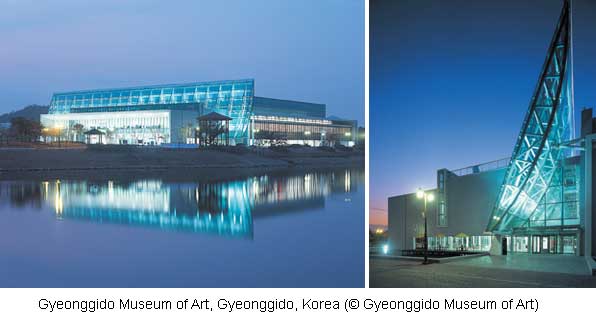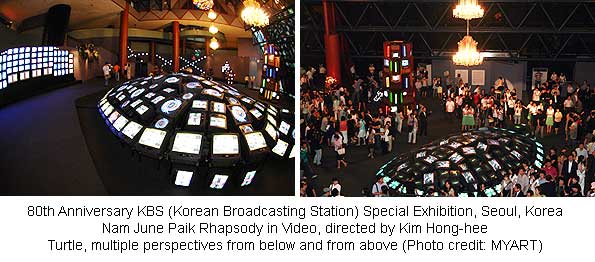Thursday, August 9th, 2007
PROGRAMMING OF GYEONGGIDO MUSEUM OF ART;
OPENING OF NAM JUNE PAIK EXHIBITION
Interview with Kim Hong-hee
About Gyeonggido Museum of Art and Nam June Paik Rhapsody in Video:
There is a new contemporary art museum in Gyeonggido, Korea. Gyeonggido surrounds Seoul and is one of the largest and most affluent provinces in Korea. As the first invited director of this museum, Kim Hong-hee speaks about her visions for the museum. Furthermore, as the artistic director for the KBS (Korean Broadcasting Station) 80th Anniversary Special Exhibition Nam June Paik Rhapsody in Video, she speaks about staging Paik’s artworks of the 90’s, his golden years.

MC: Please talk about the local/global concerns for the Gyeonggido museum. As a local museum, how are you planning on shaping the museum’s goals and visions for the future?
MC: You mention the importance of the programming; would you talk more about that?
KHH: The main features of the exhibition will be an annual exhibition that is dedicated to exploring themes of the province such as the one we had this year, the sculpture garden and green project Line in Space: 2007 Sculpture Project, and then the goal is to develop the museum’s programming with project-based events, residencies, and international exchange programs. All of this is to create a national and international, local and global museum, which places activity and liveliness ahead of anything else. Furthermore, there are some things that are seasonal to consider, for example, the summer time is an important exhibition time for youngsters so this year, we are currently showing Charge Your Imagination exhibition which displays contemporary Korean artists with artworks that are visually and conceptually stimulating as well as with some artworks that can be touched and climbed on. Essentially, what makes the Gyeonggido Museum different is that the museum’s main focus and attention, the energy and resource, is on the programming, which will change each year and be worked on and researched. Hence, the museum is directed towards a movement forward.
MC: Many international museums house collections which are essentially the same (blockbuster pre-modern to modern artworks), how is this museum different, what does it house, and how will you maintain a program based museum rather than collection based museum?
KHH: The Gyeonggido Museum is a museum that focuses more on programming (active) and also intends to house a contemporary collection that fits the identity of the museum. The museum already has about 200 contemporary art works and we have currently provided touring exhibitions from this collection, which travels around Gyeonggido.
MC: Let’s talk about the Nam June Paik exhibition at KBS. I found your exhibition interesting since it was exhibited at KBS rather than a museum and because it was a site-specific exhibition, can you speak more about the exhibition layout, staging, and theatrics of Paik’s artwork for the exhibition Rhapsody in Video?
MC: What were the difficulties in putting this exhibition together, what do you believe is the highlight, and what is the general response of it?
HKK: The most difficult aspect of the exhibition planning was utilizing a space that was not originally intended for artwork display. The highlight of the exhibition, other than the absolutely gigantic turtle piece, is the three satellite pieces that are projected side by side so that people can walk through them to watch it one at a time or at once simultaneously. Since this is the KBS’s 80th anniversary, and since KBS was one of Paik’s supporting broadcasting stations, it made sense that Paik is celebrated this way for the occasion. The public and media response is positive, the critics like it too.

Gyeonggido Museum of Art
80th Anniversary KBS (Korean Broadcasting Station) Special Exhibition
Nam June Paik Rhapsody in Video
Exhibition at Special Exhibition Hall in KBS New Bld., Yeoido, Seoul
July 27 – December 30, 2007
http://www.kbsnamjunepaik.com/
The 6th Gwangju Biennale 2006
Fever Variations